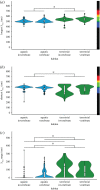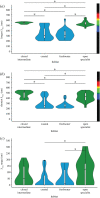Evolutionary history limits species' ability to match colour sensitivity to available habitat light
- PMID: 35582803
- PMCID: PMC9115023
- DOI: 10.1098/rspb.2022.0612
Evolutionary history limits species' ability to match colour sensitivity to available habitat light
Abstract
The spectrum of light that an animal sees-from ultraviolet to far red light-is governed by the number and wavelength sensitivity of a family of retinal proteins called opsins. It has been hypothesized that the spectrum of light available in an environment influences the range of colours that a species has evolved to see. However, invertebrates and vertebrates use phylogenetically distinct opsins in their retinae, and it remains unclear whether these distinct opsins influence what animals see, or how they adapt to their light environments. Systematically using published visual sensitivity data from across animal phyla, we found that terrestrial animals are more sensitive to shorter and longer wavelengths of light than aquatic animals and that invertebrates are more sensitive to shorter wavelengths of light than vertebrates. Using phylogenetically controlled analyses, we found that closed and open canopy habitat species have different spectral sensitivities when comparing across the Metazoa and excluding habitat generalists, while deepwater animals are no more sensitive to shorter wavelengths of light than shallow-water animals. Our results suggest that animals do adapt to their light environment; however, the invertebrate-vertebrate evolutionary divergence may limit the degree to which animals can perform visual tuning.
Keywords: ciliary opsin; light environment; meta-analysis; rhabdomeric opsin; visual tuning; λmax.
Conflict of interest statement
We declare we have no competing interests.
Figures



References
-
- Uetz GW, Roberts JA, Taylor PW. 2009. Multimodal communication and mate choice in wolf spiders: female response to multimodal versus unimodal signals. Anim. Behav. 78, 299-305. (10.1016/j.anbehav.2009.04.023) - DOI
-
- Thurman TJ, Seymoure BM. 2015. A bird's eye view of two mimetic tropical butterflies: coloration matches predator's sensitivity. J. Zool. 298, 159-168. (10.1111/jzo.12305) - DOI
-
- Endler JA. 1978. A Predator's View of Animal Color Patterns. In Evolutionary biology, vol. 11 (eds Hecht MK, Steere WC, Wallace B), pp. 319-364. New York, NY: Plenum Press.
-
- Cheroske AG, Cronin TW, Durham MF, Caldwell RL. 2009. Adaptive signalling behaviour in stomatopods under varying light conditions. Mar. Freshw. Behav. Physiol. 42, 219-232. (10.1080/10236240903169222) - DOI
Publication types
MeSH terms
Substances
LinkOut - more resources
Full Text Sources
Other Literature Sources

